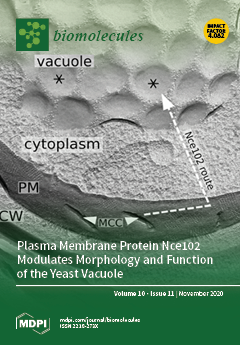Ranunculus muricatus L. is a spiny fruit buttercup that is used in various traditional medicinal systems. In the current investigation of
R. muricatus, the new chalcone 4-benzyloxylonchocarpin (
1), the new anthraquinone muracatanes A (
2), the new-to-nature anthraquinone muracatanes
[...] Read more.
Ranunculus muricatus L. is a spiny fruit buttercup that is used in various traditional medicinal systems. In the current investigation of
R. muricatus, the new chalcone 4-benzyloxylonchocarpin (
1), the new anthraquinone muracatanes A (
2), the new-to-nature anthraquinone muracatanes B (
3), and the new naphthalene analog muracatanes C (
4) were isolated, in addition to the three previously reported compounds, 4-methoxylonchocarpin (
5), β-sitosterol (
6), and β-sitosterol β-D-glucopyranoside (
7). Their structures were elucidated using 1D (
1H and
13C) and 2D (COSY, HSQC, and HMBC) NMR spectroscopy and HR-ESI-MS. Chalcone
1 showed potent acetylcholinesterase inhibitory effects with
Ki of 5.39 µM and
Ki′ of 3.54 µM, but none of the isolated compounds showed inhibitory activity towards butyrylcholinesterase. Anthraquinone
3 illustrated α-glucosidase inhibitory effects with IC
50-values of 164.46 ± 83.04 µM. Compound
5 displayed moderate cytotoxic activity towards ovarian carcinoma (A2780, IC
50 = 25.4 µM), colorectal adenocarcinoma (HT29, IC
50 = 20.2 µM), breast cancer (MCF7, IC
50 = 23.7 µM), and thyroid carcinoma (SW1736, IC
50 = 26.2 µM) while it was inactive towards pharynx carcinoma (FaDu: IC
50 > 30 µM).
Full article






